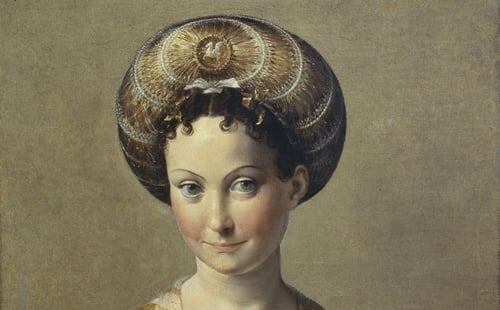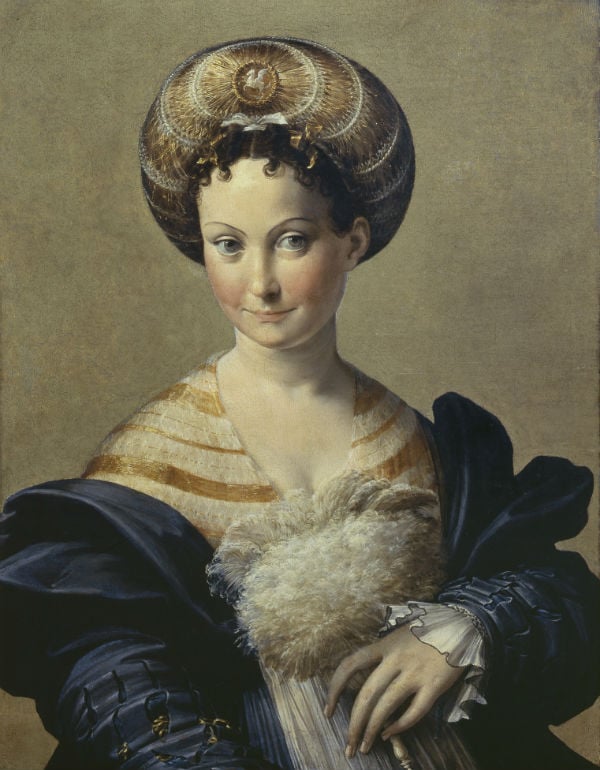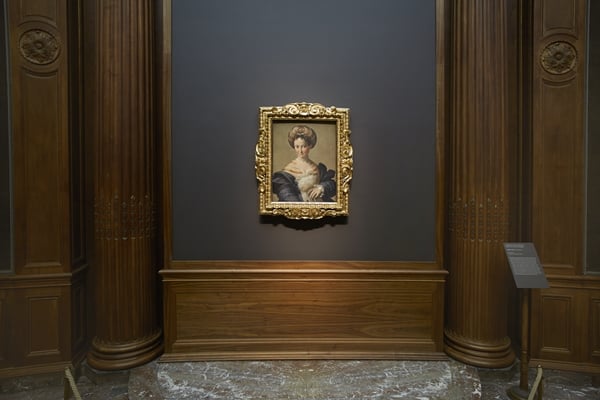Art & Exhibitions
Cracking the Parmigianino Code at the Frick
His mysterious portrait "Schiava Turca" is the subject of a single-artwork show.

His mysterious portrait "Schiava Turca" is the subject of a single-artwork show.


Francesco Mazzola, called Il Parmigianino, Schiava Turca (ca. 1531–34).
Photo: Scala/Art Resource, NY.
Vasari has an anecdote about Parmigianino (1503–40), the late-Renaissance dynamo whom the Frick Collection is currently honoring with a single-picture showcase of his phrenic female portrait, Schiava Turca (circa 1531–34).
In 1527, Vasari writes, Parmigianino was working in Rome when it was sacked by mutinying soldiers of the Holy Roman Empire. He was in his studio, so happily absorbed in painting that he apparently didn’t even notice the calamity overtaking the Eternal City until marauders actually stormed his atelier. But then, the twist: the soldiers were so overcome by the beauty of his art that they decide to let him be, asking only for some watercolors as ransom.
This is one of those colorful and unlikely anecdotes that has made Vasari such a great ambassador for the Italian Renaissance, up until the present. It can also be read as a parable about Parmigianino’s art itself. Mannerism, the hyper-refined style that he is associated with, is known for its unearthly quality, moving out of sync with material fact in a way that seems almost queasy; but the resulting other-worldliness, in turn, gives it an appeal that is also the source of its redemption. And if you look close, even the relatively sober Schiava Turca encodes this idea.
As an image, this painting (on loan from the Galleria Nazionale di Parma in Italy) exudes the fertile sense of enigma that floats art historical legends. Against a plain brown background, a woman looks out at you. Her gaze is relatively confident, with only a hint of the deference expected from Renaissance female portraiture. She is wearing a gold-threaded balzo, an elaborate round headdress, accented by a broach-like insignia of a winged horse. Elaborate, billowy blue sleeves engulf the bottom half of her form, the right one threaded through with delicate golden chains. The woman’s left hand grasps an ostrich-feather fan to her bosom.
Whom the woman is, or even whether she was a real woman, remains a mystery. Schiava Turca means “Turkish Slave,” an appellation apparently given in the early 18th century based on her turban-like headgear and chains. Aimee Ng, the curator of the current show, proposes a new interpretation: that the depicted woman was neither a passive subject nor a purely theoretical muse, but Veronica Gambara (1495-1550), an accomplished poetess who moved in courtly circles. This, Ng thinks, would explain both her relatively confident demeanor and the prominent emblem of Pegasus, which was a symbol of the font of poetic inspiration.

Installation view of “The Poetry of Parmigianino’s ‘Schiava Turca'” at The Frick Collection.
Photo: Lisa Goble.
Still, Parmigianino was quite well known for his conjuration of female beauty from ideal parts—a nose should be just so, eyes just so—and whether or not Schiava Turca was a real woman, she is clearly overlaid with an “ideal beauty” Insta-filter. The subject of Schiava Turca shares with Parmigianino’s most famous work, the idealized-to-within-an-inch-of-her-life Madonna of the Long Neck, the same dimpled chin, perfectly symmetrical curls of hair, pouting mouth, elegantly groomed eyebrows, flushed cheeks, and artfully lined neck (when extended, the Italian theorists of beauty thought, the female neck should have delicate, necklace-like lines).
Until very recently, art-historically speaking, “mannerist” was an insult. It indicated caprice passing over into disturbance. It was also thought to be connected with the spiritual crisis of the late Renaissance, which was a time of political corruption and confusion (the turbid fever dream of Michelangelo’s The Last Judgment, of 1536–1541, is “mannerist”—so different from the confident, harmonious high-Renaissance David, done in 1501–1504, when Parmigianino was just a babe.) In truth, Schiava Turca is probably not mannerist enough for modern eyes, which love surrealist exaggeration and don’t care much for demure rationality.
But look closely: It is easy to get lost in the radiantly realized serenity of the woman’s face. But let your gaze descend to her hand—that bizarre, squid-like hand. The fingers are oddly stretched, likely because Parmigianino has pressed too hard to squeeze them into the ideal of feminine fingers, which were supposed to be long, slender, and tapering. Moreover, the implied position of her thumb is all wrong to be clasping that fan. Having seen this, you then realize that the billows of her left sleeve cover a very strange jointing of the arm to her body. In fact, something weird is going on with the entire garment, which seems to more hover off of her than be something she is wearing.

Francesco Mazzola, called Il Parmigianino, Schiava Turca [detail], ca. 1531–34.
Photo: Scala/Art Resource, NY.
This is the kind of irrational tic that long gave mannerism its association with error. And yet, I think that it can be redeemed by showing how it forms part of this painting’s subconscious rhetoric. Let your eyes rise again to the top half of the painting: the key focal point is clearly that Pegasus broach, gold threads exploding out from it like a firework. Because of the way the balzo sits on the back of her head, the rings marking its contour seem to radiate away from the broach, drawing your eyes down the canvas and across her face. There, the curves are echoed in the idealized curves of her eyes, lips, chin, and neck (and rhyme with her sculpted eyebrows). Further down, the design of her blouse continues the radiating ring pattern, only now it is more diffuse, as if to suggest a halo of energy spreading outwards from her brain. But at last, at the center of the canvas, the pattern is met by the burst of the ostrich-feather fan, and everything becomes disordered—those wild sleeves, the freakish hand, the lines of her dress sweeping away at an odd direction.
In the current show’s catalogue, Ng, the curator, writes about the Pegasus broach and fan as the painting’s two symbolic poles: “The winged horse on her headdress and the fan pointed towards her chest… emphasize the sites of creative power: the head and the heart, the intellect and the soul,” she argues. But what is notable, and that Ng does not say, is that these two poles are clearly not totally in harmony here; there is a clash between the value of the brain and of the passions worked into the fabric of the composition. True, this is almost subliminal, but that very fact suggests the sense of an elegant world that is superficially holding together, but also touched, beneath it all, by wildness and disorder.
And this is fitting. Despite his polished artistic accomplishments, disorder really did haunt Parmigianino: once considered the heir of Raphael, the quintessential painter of the stylish ideal, he was deeply affected by the chaos that followed the Sack of Rome (Vasari’s charming anecdote being a brief detour). He fled Rome, to reinvent himself in Bologna and Parma. After a dizzying series of ups and downs, he died poor and relatively young at 37, known to have acquired an unholy obsession with alchemy.
“The Poetry of Parmigianino’s ‘Schiava Turca’” is on view at the Frick Collection, through July 20, 2014